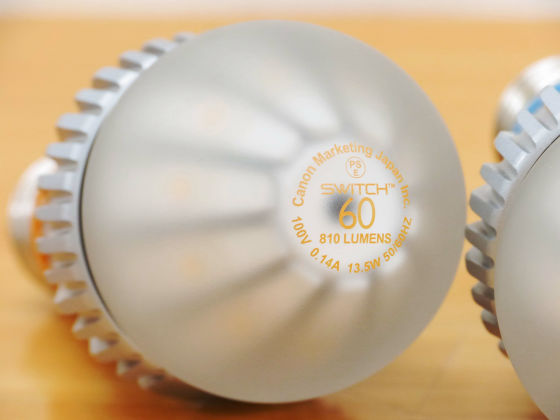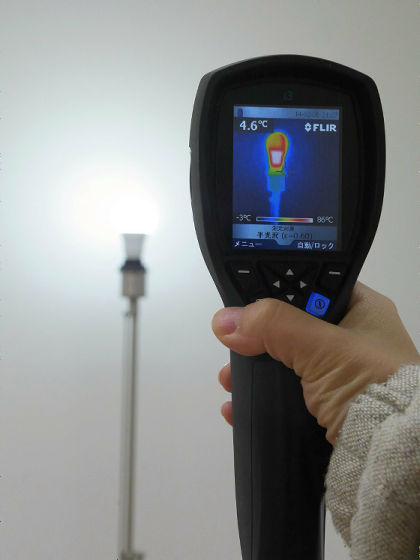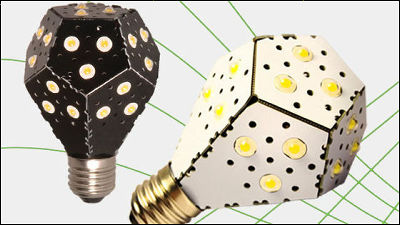Cooling system filled with liquid silicon inside bulb & I tried using LED bulb "SWITCH" light spreading to 290 degrees

The characteristic of the LED light is that the straightness is high and the light is difficult to diffuse, but it is a proprietary cooling system that fills the inside of the bulb with liquid silicon (silicone), the light can be heated to 290 degrees without increasing the temperature of the bulb LED bulb that can be extended to the range of "SWITCH"is. American in 2012Edison AwardsAwardedThe state of production was also releasedAlthough it was concerned about what kind of SWITCH it is different from the looking LED light bulb on the market, I actually bought it and tried it.
Liquid Cooling System: SWITCH LED Bulbs for residential and commercial customers
http://switchlighting.jp/
SWITCH 60 corresponding to 60 W type ordinary bulb from the left, SWITCH 80 corresponding to 80 W type ordinary bulb, SWITCH 100 corresponding to 100 W type ordinary bulb. Both were delivered in a simple package.

When opening the box, inside the LED bulb body and instruction manual.

SWITCHCompany is an American company, but the instruction manual is written in Japanese so it is safe.

SWITCH 60, SWITCH 80, SWITCH 100 are taken out from the box and it looks like the following. Since the sockets are color coded with orange, blue and green, it was supposed to know which one at a glance.

As seen from the valve side.

Since each equivalent wattage is written with color-coded letters, it can also be checked at a glance.

SWITCH is heavier than ordinary LED light bulb, when we actually measured SWITCH 60, the weight is 288 g. The brightness is 810 lm, the color temperature is 2700 K, and the power consumption is 13.5 W.

SWITCH 80 measured 287 g, the brightness is 1160 lm, the color temperature is 2700 K, the power consumption is 18.5 W.

SWITCH 100 has an actual measurement of 289 g, a brightness of 1520 lm, a color temperature of 4000 K, and a power consumption of 20 W.

The size is the same, the diameter is 59 mm, the height is 124 mm.

The most important feature of the SWITCH series is in this valve, the inside is filled with silicon, not hollow.

By filling the interior of the light bulb with liquid silicone, it has higher heat radiation than an air-cooled LED light bulb, it can be attached to a sealer or an embedded device, so brightness will not be reduced or life will not be shortened depending on the direction . Liquid silicon is also used for food samples and cosmetics, it has no conductivity, toxicity, dyeability, it is harmless to the human body and the environment, and silicon which was used in breast augment surgery in the past It is a different thing.

In addition, the feature of the LED light is that the straightness of the light is high, but SWITCH's light spread is 290 degrees. I will illuminate the neighborhood in a form more like an incandescent bulb.

So, I will actually try using it. First, left · ELPA 60 type (770 lm)Incandescent light bulb (clear bulb)And SWITCH 60 to the right. As you can see from the image below, SWITCH 60 is a slightly brighter impression than an incandescent bulb, there is no unevenness of light, and because there is no shadow by the internal lead-in wire, SWITCH 60 can evenly illuminate the interior. In addition, SWITCH 60 and SWITCH 80 are shades similar to an incandescent light bulb with 2700 K and orange.

Next, left · SWITCH 60, middle ·Toshiba Lightitech General bulb type equivalent to 60 W,right·Panasonic LED bulb Wide light distribution type bulb 60 W typeWhen compared, it looks like the following. There is almost no difference in the brightness of the wall, but whether the color is different or not, SWITCH 60 stand feet slightly dark impression. In both cases, the brightness is 810 lm, the color temperature of Toshiba Lighting Tec and Panasonic LED bulbs is not disclosed, but both are "bulb color" closer to orange.Experiment as of 2009But, as each LED light gave a big difference, the technology seems to be progressing, the general light distribution type and the wide type light bulb have a considerable range even if the light spread is less than 290 degrees I was illuminating.

From the left, compare incandescent light bulbs, SWITCH 60, Toshiba lighting tech general bulb type 60 W equivalent, Panasonic LED light bulbs wide light distribution type bulb 60 W equivalent. You can see that SWITCH 60 is the closest to the color of the incandescent bulb among the three types of LEDs, and the others are slightly orangeed. Both brightness is 1160 lm.

Next left · SWITCH 80 and right ·Toshiba Lightitech General bulb type equivalent to 80 WCompare. Although the brightness is also the same here, the Toshiba Light Tech looks reddish slightly, the stand of the SWITCH 80 feet is a bit dark impression.

Left · SWITCH 100 and right ·Toshiba Lightitech General bulb type equivalent to 100 WLet's compare. The brightness is the same as 1520 lm, but the color of SWITCH 100 is 4000 K, while Toshiba Lightitec is slightly bluish with 5000 K, Toshiba Lightitech is a dark impression.

SWITCH is characterized by its brightness does not change depending on the installation location, so I tried installing it on the ceiling too. First of all SWITCH 60.

SWITCH 80.

SWITCH 100 is like this.

Left · SWITCH 60, medium · Toshiba Lightitech general bulb type 60 W equivalent, right · Panasonic LED bulb · wide light distribution type bulb 60 W type, equivalent to this type. Neither brightness changes much, the SWITCH light hitting the wall is distinctive, and the part near the light bulb looks somewhat bright.

Left · SWITCH 80 and right · TOSHIBA LIGHTEC General light bulb type 80W or less is compared below. The light of Toshiba Lightitech seems to be slightly reddened, and like SWITCH 60, SWITCH 80 has a characteristic in how light hits, and as it gets closer to the floor, there is no difference, but the periphery of the light bulb feels somewhat bright.

And at the end left · SWITCH 100 and right · Toshiba Lightitech general bulb type 100 W equivalent. As with the stand, color difference is big, there is a difference in impression. Here too SWITCH 100 is illuminated slightly brighter around the bulb.

There was not much difference in brightness between SWITCH and other LED bulbs, but is there a difference in temperature rise? By saying that,Infrared thermography "FLIR i 3" that can measure temperature and save images simply by holding anything on itTo compare SWITCH 100 with Toshiba Lightitech general bulb type 100 W equivalent.

First of all, Toshiba Lighting Tech general bulb type The temperature rise equivalent to 100 W is as follows. After 15 minutes · 30 minutes after turning on the light from the left, the temperature of the light bulb body rises to 64 degrees after 15 minutes after turning on the light, after 30 minutes it is 78 degrees. Also, you can see that the air around the bulb is warmed to a wide range.

On the other hand, the following is how the temperature of SWITCH 100 rises. The temperature of the light bulb rises to 58 degrees after 5 minutes after adding the light, and after 30 minutes there are also 74 degrees depending on the location, but the range where the surrounding air is heated is limited, depending on the cooling system You can see that the temperature rise is less affected to the outside of the bulb.

Also, unusually for LED light bulbs of 60 W or more equivalent, SWITCH supports its dimmer by its own technology. When light is reduced, small light appears as if to draw a circle, and a stylish atmosphere can be produced.

You can also light up as a normal light by enlarging the light.

You can see how you actually use SWITCH with light with dimming function from the following movie.
I tried dimming LED bulb SWITCH 60 - YouTube
Also, some commercial LED bulbs can not be used with sealed luminaires because of heat, but in the case of SWITCH, the cooling system is established, it is possible to use sealed luminaires without problems.

It can be used as a light for a bathroom.

So, SWITCH was brighter than the 60 incandescent bulb, but it was able to emit light more uniformly, but it is clearly different from the 60 W LED bulb sold by Toshiba and Panasonic There was no difference in brightness. Lighting around the bulb is somewhat bright when attached to the wall, light like when it reflects on the glass appears on the wall, but there is almost no difference as a feeling when actually standing under the light bulb Impression of a slightly dark. However, since dimming is possible and the appearance when light is reduced is quite stylish, the point that can be used as an interior with a light that can see a light bulb is quite good. It is still worth noting that even with the cooling system, the life is prolonged by being cooled, and even in the situation that every model has an average life expectancy of about 40,000 hours, 6 hours a day To the calculation that can be used for about 18 years. Furthermore, since the influence of the ambient air on the temperature is small, SWITCH becomes more advantageous as it is a sealed space or a place where it is often to leave it running all the time.
In addition, the price is SWITCH 60 6890 yen including tax, SWITCH 80 8610 yen including tax, SWITCH 100 is 9800 yen including tax, both are3 year free warrantyIt is attached.

Related Posts:







